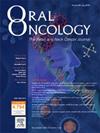The impact of HER2-Low expression in salivary duct carcinoma: Clinicopathologic features, survival outcomes, and association with androgen receptor-targeted therapy
IF 4
2区 医学
Q1 DENTISTRY, ORAL SURGERY & MEDICINE
引用次数: 0
Abstract
Objectives
Recent advances in systemic therapy for salivary duct carcinoma (SDC) have been driven by the development of HER2- and androgen receptor (AR)-targeted therapies. Trastuzumab deruxtecan has proven effective not only in HER2-positive but also HER2-low breast and gastro-esophageal cancers. However, the significance of HER2-low expression in SDC remains unknown. This study aimed to investigate the clinicopathologic characteristics, prognostic implications, and impact on efficacy to AR-targeted therapy in HER2-low SDC.
Materials and Methods
This was a multi-center, observational study. HER2 status was reclassified as follows: HER2-positive (IHC3+ or 2+/ISH+ ), HER2-low (IHC1+ or 2+/ISH-), and HER2-zero (IHC0). The subjects were compared in three groups: total population, curative treatment cohort, and AR-targeted therapy cohort.
Results
The total population consisted of 526 patients, of whom, 271 (52 %), 184 (35 %), and 71 (13 %) had HER2-positive, -low, and -zero tumors, respectively. Sex, M category, histological origin, Ki67, and p53 expression differed significantly between the HER2-low and HER2-positive cases. No differences in relapse-free or overall survival were observed for HER2 status in the curative treatment cohort; however, in the AR-targeted therapy cohort, the HER2-low group had significantly better response rates (41.6 % vs. 18.9 %, Odds ratio = 0.30, P = 0.012) and longer median progression-free survival (6.9 vs. 4.2 months, Hazard ratio = 1.61, P = 0.029) than those of the HER2-positive group.
Conclusion
HER2-low showed different clinicopathologic features from HER2-positive cases, with no prognostic differences observed in patients who underwent curative treatment. Still, HER2-low may be associated with the efficacy of AR-targeted therapy.
唾液腺导管癌中 HER2 低表达的影响:临床病理特征、生存结果以及与雄激素受体靶向治疗的关系
目的:近期涎腺管癌(SDC)的全身治疗进展是由HER2和雄激素受体(AR)靶向治疗的发展推动的。曲妥珠单抗deruxtecan已被证明不仅对her2阳性,而且对her2低的乳腺癌和胃食管癌有效。然而,her2低表达在SDC中的意义尚不清楚。本研究旨在探讨低her2水平SDC的临床病理特征、预后意义以及ar靶向治疗对疗效的影响。材料与方法本研究为多中心观察性研究。HER2状态重新分类如下:HER2阳性(IHC3+或2+/ISH+), HER2低(IHC1+或2+/ISH-)和HER2零(IHC0)。将受试者分为三组进行比较:总人口、治愈治疗组和ar靶向治疗组。结果526例患者中,her2阳性、低、零肿瘤分别为271例(52%)、184例(35%)、71例(13%)。性别、M类型、组织学来源、Ki67和p53表达在her2低和her2阳性病例之间存在显著差异。在治愈治疗组中,HER2状态的无复发生存期或总生存期未观察到差异;然而,在ar靶向治疗队列中,her2低组的有效率明显高于her2阳性组(41.6% vs. 18.9%,优势比= 0.30,P = 0.012),中位无进展生存期(6.9 vs. 4.2个月,风险比= 1.61,P = 0.029)。结论her2 -low与her2阳性患者表现出不同的临床病理特征,但经根治性治疗的患者预后无差异。尽管如此,her2低水平可能与ar靶向治疗的疗效有关。
本文章由计算机程序翻译,如有差异,请以英文原文为准。
求助全文
约1分钟内获得全文
求助全文
来源期刊

Oral oncology
医学-牙科与口腔外科
CiteScore
8.70
自引率
10.40%
发文量
505
审稿时长
20 days
期刊介绍:
Oral Oncology is an international interdisciplinary journal which publishes high quality original research, clinical trials and review articles, editorials, and commentaries relating to the etiopathogenesis, epidemiology, prevention, clinical features, diagnosis, treatment and management of patients with neoplasms in the head and neck.
Oral Oncology is of interest to head and neck surgeons, radiation and medical oncologists, maxillo-facial surgeons, oto-rhino-laryngologists, plastic surgeons, pathologists, scientists, oral medical specialists, special care dentists, dental care professionals, general dental practitioners, public health physicians, palliative care physicians, nurses, radiologists, radiographers, dieticians, occupational therapists, speech and language therapists, nutritionists, clinical and health psychologists and counselors, professionals in end of life care, as well as others interested in these fields.
 求助内容:
求助内容: 应助结果提醒方式:
应助结果提醒方式:


